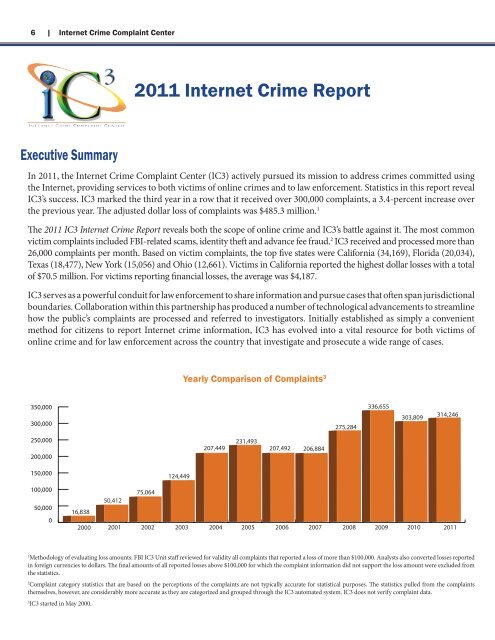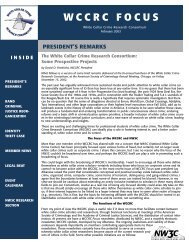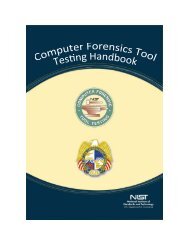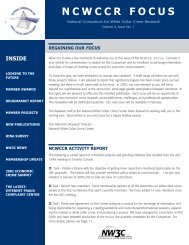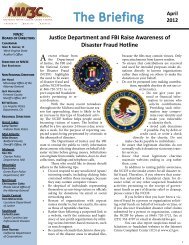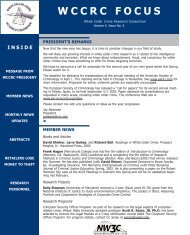2011 Annual Report - Internet Crime Complaint Center
2011 Annual Report - Internet Crime Complaint Center
2011 Annual Report - Internet Crime Complaint Center
Create successful ePaper yourself
Turn your PDF publications into a flip-book with our unique Google optimized e-Paper software.
6 | <strong>Internet</strong> <strong>Crime</strong> <strong>Complaint</strong> <strong>Center</strong><br />
1<br />
<strong>2011</strong> <strong>Internet</strong> <strong>Crime</strong> <strong>Report</strong><br />
Executive Summary<br />
In <strong>2011</strong>, the <strong>Internet</strong> <strong>Crime</strong> <strong>Complaint</strong> <strong>Center</strong> (IC3) actively pursued its mission to address crimes committed using<br />
the <strong>Internet</strong>, providing services to both victims of online crimes and to law enforcement. Statistics in this report reveal<br />
IC3’s success. IC3 marked the third year in a row that it received over 300,000 complaints, a 3.4-percent increase over<br />
the previous year. The adjusted dollar loss of complaints was $485.3 million. 1<br />
The <strong>2011</strong> IC3 <strong>Internet</strong> <strong>Crime</strong> <strong>Report</strong> reveals both the scope of online crime and IC3’s battle against it. The most common<br />
victim complaints included FBI-related scams, identity theft and advance fee fraud. 2 IC3 received and processed more than<br />
26,000 complaints per month. Based on victim complaints, the top five states were California 336,655 (34,169), Florida (20,034),<br />
Texas (18,477), New York (15,056) and Ohio (12,661). Victims in California reported the highest dollar losses with a total<br />
of $70.5 million. For victims reporting financial losses, the average was $4,187.<br />
IC3 serves as a powerful conduit for law enforcement to share information and pursue cases that often span jurisdictional<br />
boundaries. Collaboration within this partnership has produced a number of technological advancements to streamline<br />
how the public’s complaints are processed and referred to investigators. Initially established as simply a convenient<br />
method for citizens to report <strong>Internet</strong> crime information, IC3 has evolved into a vital resource for both victims of<br />
online crime and for law enforcement across the country that investigate and prosecute a wide range of cases.<br />
314,246<br />
Yearly Comparison of <strong>Complaint</strong>s 3<br />
350,000<br />
300,000<br />
275,284<br />
336,655<br />
303,809<br />
314,246<br />
250,000<br />
200,000<br />
207,449<br />
231,493<br />
207,492 206,884<br />
150,000<br />
100,000<br />
50,000<br />
0<br />
124,449<br />
75,064<br />
50,412<br />
16,838<br />
2000 2001 2002 2003 2004 2005 2006 2007 2008 2009 2010 <strong>2011</strong><br />
1<br />
Methodology of evaluating loss amounts: FBI IC3 Unit staff reviewed for validity all complaints that reported a loss of more than $100,000. Analysts also converted losses reported<br />
in foreign currencies to dollars. The final amounts of all reported losses above $100,000 for which the complaint information did not support the loss amount were excluded from<br />
the statistics.<br />
2<br />
<strong>Complaint</strong> category statistics that are based on the perceptions of the complaints are not typically accurate for statistical purposes. The statistics pulled from the complaints<br />
themselves, however, are considerably more accurate as they are categorized and grouped through the IC3 automated system. IC3 does not verify complaint data.<br />
3<br />
IC3 started in May 2000.


